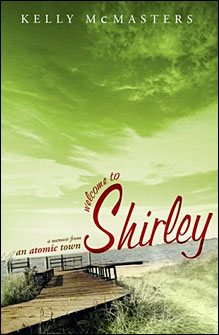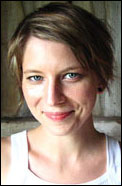
This is a really great web site with some beautiful images of some antique scientific equipment. Definitely worth checking out.

Thursday, April 24, 2008

Last week, author and former Shirley resident Kelly McMasters published her first book, Welcome to Shirley: A Memoir from an Atomic Town (PublicAffairs Books, $24.95). It is based on memories and anecdotes from her childhood, interwoven with the history of operations, contamination, and cleanup at BNL. The author relates several health tragedies from her former neighborhood, about six miles south of the Lab, and implies that BNL was responsible for them.
McMasters is promoting her book through book signings and national radio ads, and several local and at least one national publication ("O," the Oprah magazine) have reviewed the book.
McMasters writes in an author's note that the book is factual and based on extensive research - claims that are contradicted by multiple factual errors, especially in the sections relating to BNL. She also ignores several epidemiological studies that offer scientific evidence counter to her primary claim - that cancer clusters caused by BNL operations surround the Lab.
Other prominent errors include statements that the Lab is funded primarily by the U.S. Department of Defense, and insinuations that Shirley residents were exposed to chemicals from BNL in groundwater (see below for accurate information on these topics). In addition, many lesser errors of fact, geography, and history, along with inaccurate inferences and insinuations, can be found throughout the book.
The BNL Research Library has ordered two copies, and they should be available now for anyone who is interested in reading the book.
In 2006, the Bulletin published a lengthy rebuttal to a McMasters' Op-Ed article called "The Nuclear Neighborhood" that appeared in The New York Times. Welcome to Shirley is similar to that Op Ed in that it also presents an often-inaccurate depiction of the Lab, the environmental cleanup at BNL, and health issues on Long Island. Below is an updated version of that original rebuttal, which responds to some of Welcome to Shirley's claims.
Claim: Cancer clusters surround Brookhaven Lab. For many of these cancers, including breast cancer, the only proven cause is exposure to low-level radiation.

McMasters
The Facts: McMasters uses anecdotes, innuendo, and selective information to imply that the Laboratory is responsible for an increase in cancer rates. She neglects to mention two epidemiological studies of cancer rates that found no relationship between BNL and cancer.
According to a 1998 report by the Suffolk County Environmental Task Force on BNL, which looked at rates within a 15-mile radius of BNL, "cancer rates of all types of cancers [the task force] studied are not elevated near BNL" for the years 1979-93. Task Force Chairman Roger Grimson, a biostatistician and an associate professor at Stony Brook University, concluded in a January 23, 1998, Newsday article, "There is no link between Brookhaven National Lab and cancer."
Regarding breast cancer, the study found that, compared to the rest of Long Island, rates were rising significantly, and more quickly, on the Island's East End, on both the North and South Forks. As Newsday reported: "Concerning breast cancer, Grimson said, the study does not implicate Brookhaven National Laboratory or any other particular facility or cause and noted that the breast cancer rate in the area immediately surrounding the lab is lower than on the North and South Forks."
An assessment of cancer in BNL workers conducted by the New York State Department of Health in 2001 (see full report [PDF]) concluded that the overall distribution of cancers in past and present Laboratory employees for whom data were available is similar to the patterns of cancers found in three comparison populations: residents of upstate New York, those living in Nassau, and those residing in Suffolk. "Of particular note," commented the author of the assessment report, Maria Schymura, Director of the New York State Department of Health Cancer Registry, is the fact that solid cancers that could be the result of radiation exposure "were not proportionally elevated" in the BNL population.
Claim: An epidemic of a rare childhood cancer, rhabdomyosarcoma, has been identified within a 15-mile radius of Brookhaven National Lab. The only known cause of this cancer is exposure to low-level radiation.
The Facts: When this concern was brought to the attention of county and state agencies, they conducted several investigations to look into rhabdomyosarcoma rates in the area. No clusters or links to BNL were found. A November 14, 2002, article in Newsday reported that "An analysis of rhabdomyosarcoma rates by the state health department has found that the rate in central Suffolk, where the laboratory is located, does not differ significantly from rates in eastern and western Suffolk, and that Suffolk's overall rate does not differ significantly from the rest of the state."
In 1998, a study released by the Suffolk County Environmental Task Force, a group that included some of the Laboratory's most ardent critics, found "there is no statistical evidence showing higher than normal rates in either Suffolk County or a 15-mile radius of the Lab. In fact, there were fewer cases of rhabdomyosarcoma in Suffolk County from 1979 through 1993 than there were on average in other New York State counties, including Nassau, Brooklyn and Queens." According to the New York State Health Department, for each million people under age 19, rhabdomyosarcoma occurred annually at a rate of 4.1 cases in Suffolk, 5.3 statewide, 5.6 in Nassau, 6.4 in Queens and 7.0 in Brooklyn. McMasters' book also states that the "only" cause of rhabdomyosarcoma is exposure to low-level radiation. In reality, published risk factors cited on the American Cancer Society (ACS) website include five specific inherited medical conditions, with no mention of low-level radiation exposure. ACS also states that there are "no environmental factors (such as exposures during the mother's pregnancy or in early childhood) that are known to increase the chance of getting rhabdomyosarcoma."
Claim: Residents south of the Lab in Shirley have been exposed to chemicals in groundwater, and that is why DOE provided public water hookups to area residents.
The Facts: In 1996, off-site chemical groundwater contamination - related to Camp Upton and the Lab's historical use of solvents to clean metals - was discovered in the area south of the site. The Suffolk County Department of Health Services tested more than 800 private wells and found no contamination attributable to BNL - a finding that was confirmed by Newsday's yearlong investigative series in 1998 on the Lab's environmental impact. Nevertheless, as a precautionary measure, the Department of Energy funded the connection of more than 1,500 homes south and east of BNL to public water supplies.
Since 1996, the Lab has installed more than 3,000 temporary and permanent groundwater monitoring wells to accurately determine the nature and extent of the contamination. Sixteen treatment systems were installed between 1997 and 2005 and are operating to effectively remove solvents and similar chemicals from groundwater on and off the Lab site.
Claim: Brookhaven Lab is funded primarily by the Department of Defense.
The Facts: McMasters repeats this claim several times in the book. The Department of Defense (DOD) also funded the Long Island Breast Cancer Study, and she repeatedly implies that this supposed conflict of interest explains why the study's results were inconclusive with regard to breast cancer causes. She also insinuates that the Lab prospers from sales of breast cancer postal stamps, since a portion of the proceeds go to DOD.
In reality, the vast majority of BNL's funding comes from DOE's Office of Science. In fiscal year 2007, DOD funding represented 0.5 percent (one-half of one percent) of the Lab's overall budget. Over the past 15 years, DOD funding of BNL averaged 0.8 percent, with a high of 3 percent in 1995. Prior to 1993, DOD funding was never higher than 2 percent of the total BNL budget.
Claim: "Judging from appearances" BNL has become "a model neighbor."
The Facts: Near the book's conclusion, McMasters summarizes activities the Lab undertakes to open up to the community - including the formation of the Community Advisory Council in 1998, Summer Sunday tours, educational program initiatives, and environmental, safety & health improvements - but then uses the phrase "judging by appearances" to imply that BNL is not really a good neighbor.
While McMasters sounds doubtful, the examples of Lab openness she notes are true. The Lab regrets the negative environmental impacts of the past, but is proud of its achievements during the last 12 years in cleaning up the environment and becoming a good environmental steward and good neighbor. It has instituted international standards through the ISO 14001 registration - as well as an award-winning pollution prevention program. Managers consider how their programs may impact the internal and external communities, and work to keep stakeholders informed and involved.
Finally, the Lab's education and outreach programs have been active and creative in forming partnerships with the community.